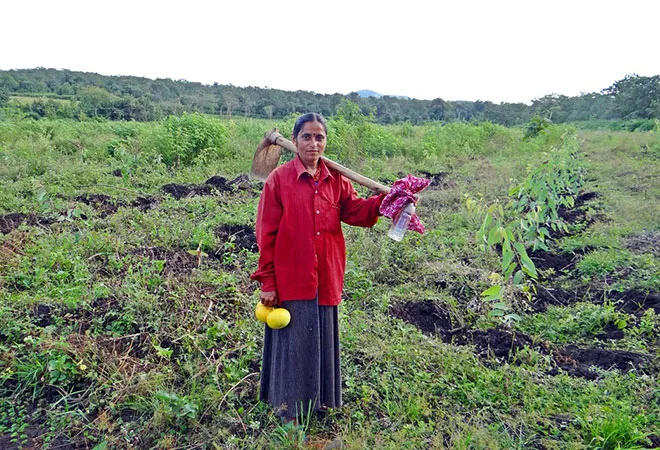-
CENTRES
Progammes & Centres
Location
Half of India’s population is women, and according to a World Bank report, India could achieve double digit growth if women were participating more in labour force. Still, unfortunately, few people are talking about women’s employment specifically and are more worried about youth unemployment.

Meeting for the first time, the Prime Minister’s Economic Advisory Council recently outlined 10 areas for focus attention. Unfortunately women’s employment does not figure in it as a separate category. It is, however, a serious problem that women’s participation in labour force is declining sharply. Women’s labour force participation rate was 25.51 per cent according to the National Sample Survey ( 68th Round) estimates in 2011-12. It was only 24.8 per cent in rural and 14.7 per cent in urban areas.
According to the latest World Bank data, Women’s Labour Force Participation Rate (LFPR) is 27 per cent ( 2016). No one, however, is surprised that women are not getting jobs in today’s tight labour market. When the jobs are scarce, who would want to choose a woman vis-à-vis a man? A man can work for long hours, does not need maternity leave and is safe to travel. In the construction work, women have to be provided with mandatory crèche facilities.
There are many reasons why women’s participation in labour force has been declining for some years in India and is the lowest among countries in South Asia after Pakistan. Nepal, Bhutan, Bangladesh have higher female employment to population ratios. These regions are characterised by high male migration to India and the women are left behind to work in the fields to produce food for the family. The contribution of women in India to GDP is only 17 percent -- less than half the global average of 37 percent. As IMF chief Christine Lagarde said, India’s GDP would be 27 per cent higher if more women participated in the labour force.
Lack of availability of agricultural and non agricultural jobs in rural areas is mainly responsible for lower participation of women in the rural work force in India as productivity in agriculture has declined leading to shrinkage in farm jobs and there is also increasing use of mechanisation.
While men can find jobs in manufacturing and service industries after leaving farming, there are fewer openings for women. Many married women leave work in rural areas to look after children. The decline can also be attributed to better education opportunities for girls in the 15-24 years age group and higher incomes of households.
There is, however, the overall grip of patriarchy on the lives of young girls in rural areas and they are not allowed to go out to faraway places to work. In China, girls from rural areas customarily work in factories and live in hostels till they earn a desired sum of money to make them financially secure in order to get married and settle down. In India, hostels and dormitories for women workers are not commonly found.
MGNREGA has also led to a rise in women’s wages and enhanced household incomes in the villages which have enabled them to withdraw from the labour force. In village, India women staying at home often reflects enhanced family’s social status.
In urban areas, two thirds of women with college degrees are without jobs. Many women also choose not to work with growing prosperity in cities. In rich urban areas of New Delhi, one sees clubs and upscale restaurants full of women having ‘kitty parties’. They come from the upper crust of Delhi society to meet women in similar circumstances and relieve their boredom.
Many women even if they are inclined to work cannot find suitable jobs. The motivation remains weak because the husbands are providers and women do not need to earn money to support the family. But millions of women in India would benefit if they could earn money instead of doing unpaid work at home the whole day. It would supplement the family’s income and the women would have greater say in decision making within the household. Even the children’s health and education would improve if the mother works.
The trend towards Nuclear families has led women to leave the work force because there is lack of support from other family members, including husbands. According to an OECD (2012) report, men in India do not help much in household chores. India’s gender chore gap is huge because on an average, a woman spends 351.9 minutes per day on unpaid work while men spend only 51.8 minutes.
Half of India’s population is women (around 600 million) and according to a World Bank report, India could achieve double digit growth if women were participating more in labour force. It would go towards decreasing poverty faster. According to the feminisation of work hypothesis, what is happening in India is quite common—it is a U shaped curve because at first women’s labour participation declines and then rises again when the stigma against work is lessened. At first the decline is due to education and husband’s education which enables women to leave menial and unpleasant jobs. Then with better skill training, lower fertility rates and higher salaries they return to work where the job status is also higher.
According to the feminisation of work hypothesis, what is happening in India is quite common—it is a U shaped curve because at first women’s labour participation declines and then rises again when the stigma against work is lessened
Unfortunately today few people are talking about women’s employment specifically and are more worried about youth unemployment. But there are various ways in which women can be encouraged to work which is good for their own self-worth and welfare of their families. First, there will have to be more job opportunities created for women especially in labour intensive industries like garments and textiles, leather, handicrafts as well as in education and healthcare. Women have been stereotyped as secretaries and clerks or teachers and nurses in the west but today they are in all types of corporate, industrial and service sector jobs.
Thus there has to be training and higher education for women to enable them to compete for specialised jobs.
In urban areas, women can find jobs in education, corporate sector, retail trade, domestic work, and services like nursing, hotels and beauticians/hairdressing. The challenges faced by women in the work place must however be addressed because they have to combat patriarchal hierarchy in offices, sexual harassment and often lack appropriate infrastructure in the work place, like separate toilets. These act as de-motivators for women to join the work force. In farms, there has to be special agricultural machinery designed for use by women and they need good and reliable means of transportation to commute to cities to sell their wares. Rural self- employed women need micro finance and institutional support for marketing their products. From every point of view, women’s work is important and should be addressed separately.
The views expressed above belong to the author(s). ORF research and analyses now available on Telegram! Click here to access our curated content — blogs, longforms and interviews.

Jayshree Sengupta was a Senior Fellow (Associate) with ORF's Economy and Growth Programme. Her work focuses on the Indian economy and development, regional cooperation related ...
Read More +
David Rusnok Researcher Strengthening National Climate Policy Implementation (SNAPFI) project DIW Germany
Read More +